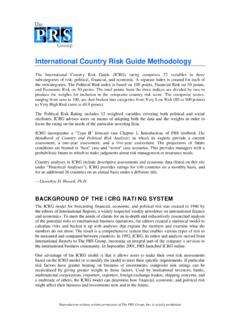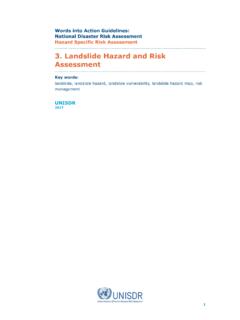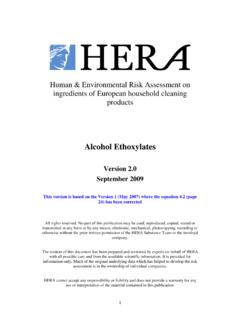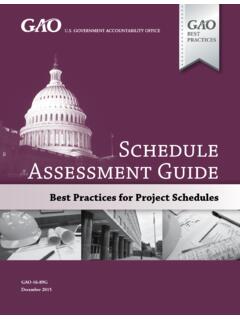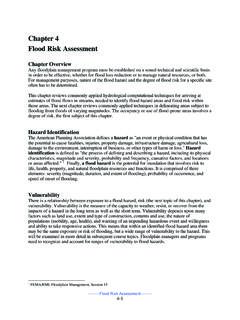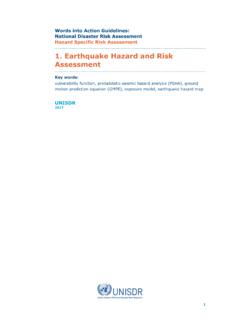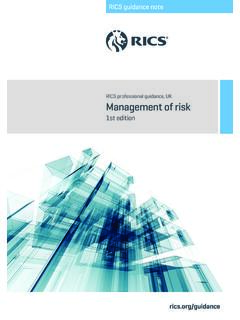Transcription of Introduction to Fault Tree Analysis - George Mason University
1 5180 Parkstone Drive Suite 260 Chantilly, VA 20151 (703) 378-8672 Management for System Safety: Introduction to Fault Tree AnalysisGuest Lecture SYST 460/560:Michael Scher7 December 20095180 Parkstone Drive Suite 260 Chantilly, VA 20151 (703) 378-8672 What is Fault Tree Analysis ? Relevant Definitions Role of FTA in Decision Making probabilistic Risk assessment Complete Analysis Considerations FTA Steps Ground Rules FTA Gate Symbols Simple Implementation Example Multi-engine Aircraft Example with probabilistic Risk Assessment5180 Parkstone Drive Suite 260 Chantilly, VA 20151 (703) 378-8672 is Fault Tree Analysis (FTA)? FTA is a powerful tool for understanding component and subsystem interactionsthat can cause a hazardous event Top-down, qualitative failure Analysis methodology that systematically deduces the root causes of an undesired, hazardous event Logicalillustration of events and relationships that are necessary and sufficient to result in event NOTa model of all possible system failuresor causes of system failure NOTa quantitative model, but can be used to support quantitative Analysis ( , probabilistic Risk assessment )5180 Parkstone Drive Suite 260 Chantilly, VA 20151 (703)
2 378-8672 Definitions Fault unexpected response in which functionality is recoverable by fixing it, managing around it, or redundancy Failure unexpected response in which functionality is NOT recoverable Primary Failure component failure that cannot be further defined in a Fault Tree Example: component on computer circuit board fails Secondary Failure component failure that could be defined further but is not due to ground rules Example: computer failure (not interested in details) Command Fault inadvertent or untimely normal operation of a component Example: draw bridge opens at wrong time due to operator entering command at improper time Common Cause Failure failures that are common to multiple parts due to poor material choice, manufacturing defects, Parkstone Drive Suite 260 Chantilly, VA 20151 (703) 378-8672 of FTA for Decision Making Understand logic that leads to top event Prioritization of contributors that lead to top event Proactive tool to prevent top event Monitor system performance Optimize resources Assist in system design Identify and correct causes of top event5180 Parkstone Drive Suite 260 Chantilly, VA 20151 (703) 378-8672 Risk assessment probabilistic Risk assessment (PRA)assigns probabilitiesof each event, or combination of events, in the Fault Tree to determine the likelihood of the top event Probability of failure (success)
3 Calculated through PRA of a particular event is only as good as the estimatesof component reliability PRA is only effective if the Fault tree and associated probabilities is regularly updated to reflect system changes5180 Parkstone Drive Suite 260 Chantilly, VA 20151 (703) 378-8672 Considerations: Top-down and Bottom-up FTA uses top-down event Analysis , which may not encompass all possible causes Use of Bottom-up analyses allow evaluation of low-level failure consequences Parts Count Any single component failure leads to system failure Failure Mode and Effect Analysis (FMEA) ID and quantify component single failure modes Failure Mode Effect and Criticality Analysis (FMECA) Similar to FMEA, with criticality, assurances and controls to limit failures Preliminary Hazard Analysis (PHA) Hazards posed by the system Reliability Block Diagram (RBD) Elemental diagram of components based on system-success pathways5180 Parkstone Drive Suite 260 Chantilly, VA 20151 (703)
4 378-8672 Steps Identify objective Define top event Define scope Define resolution Define ground rules Construct Fault tree Evaluate Fault tree Interpret resultsImage from NASA Fault Tree Handbook with Aerospace Applications5180 Parkstone Drive Suite 260 Chantilly, VA 20151 (703) 378-8672 Paradigm and Basic Rules Think small Immediate causes of the event small steps Clearly write the events as faults; state precisely what the Fault is and the conditions under which it occurs. Do not mix successes with faults Event is classified as state of component Fault if Fault is a component failure, otherwise event is a state of system Fault If the normal functioning of a component propagates a Fault sequence, the component is assumed to function normally Each level of Fault tree should be completed before moving to lower level Fault tree should be constructed to major component level Individual circuit board, but not transistors5180 Parkstone Drive Suite 260 Chantilly, VA 20151 (703) 378-8672 Gate SymbolsInputOutputABA and B000100010111 AND GateInputOutputABA or B000101011111OR GateInputOutputANOT A0110 NOT GateInputOutputABA nand B001101011110 NAND GateInputOutputABA xor B000101011110 XOR GateInputOutputABA nor B001100010110 NOR Gate5180 Parkstone Drive Suite 260 Chantilly, VA 20151 (703)
5 378-8672 Example FTA Implementation Step 1: Objective: Evaluate possible sources of failure of lightsystem. Step 2: Top Event: Light fails off. Step 3: Scope: Will be limited to components internal to system. Step 4: Resolution: Focus on major system components. Step 5: Ground Rules: Will not include human errors. Will not consider common cause failuresLightSwitchBatteryController5180 Parkstone Drive Suite 260 Chantilly, VA 20151 (703) 378-8672 Tree ConstructionLightSwitchBatteryController Light Fails OffLight Bulb FailsNo PowerBattery FailsController Opens SwitchSwitch Fails Open5180 Parkstone Drive Suite 260 Chantilly, VA 20151 (703) 378-8672 Aircraft Example Objective: Evaluate possible sources of failure of 2 engines. Top Event: Loss of 2 engines. Scope: Will be limited to components internal to system. Resolution: Focus on major system components.
6 Ground Rules: Multiple human errors will not be considered5180 Parkstone Drive Suite 260 Chantilly, VA 20151 (703) 378-8672 Fault Tree ConstructionLoss of 2 Engines#1 and #2 Fail#1 Fails, #2 is Shut Down#2 Fails,#1 is Shut Down#1 Fails#2 FailsInappropriate Crew ResponseFatigueMaintenance ErrorPoor Training#1 FailsInappropriate Crew Response#2 FailsFatigueMaintenance ErrorPoor Training5180 Parkstone Drive Suite 260 Chantilly, VA 20151 (703) 378-8672 Risk assessment of 2 Engine Failures Determine Cut Sets set of events that lead to top event Determine Minimum Cut Sets minimum set of events that lead to top event (can be several combinations) Determine failure probabilities: : component failure rate t: relevant time interval P = 1 e- t P(top) = P(Mi) = P(BE1)P(BE2)..P(BEk) OR gate: P(A or B) = P(A) + P(B) P(A B) Using rare event approximation: P(A OR B) = P(A) + P(B), generates conservative estimate AND gate: P(A and B) = P(A)*P(B)5180 Parkstone Drive Suite 260 Chantilly, VA 20151 (703) 378-8672 Minimum Cut SetsLoss of 2 Engines#1 and #2 Fail#1 Fails, #2 is Shut Down#2 Fails,#1 is Shut Down#1 Fails#2 FailsInappropriate Crew ResponseFatigueMaintenance ErrorPoor Training#1 FailsInappropriate Crew Response#2 FailsFatigueMaintenance ErrorPoor TrainingABABCDECDEF1F2F3F4F45180 Parkstone Drive Suite 260 Chantilly, VA 20151 (703) 378-8672 Minimum Cut Sets (cont) Use top-down substitution: T = F1 + F2 + F3, F1 = A*B, F2 = A*F4, F3 = B*F4, F4 = C + D + E T = A*B + A*F4 + B*F4 T = A*B + A*(C + D + E) + B*(C + D + E) T = A*B + A*C + A*D + A*E + B*C + B*D + B*E Results in 7 Cut Sets.
7 A: Engine 1 Fails, Engine 2 Fails B: Engine 1 Fails, Crew Shuts Down Engine 2 Due to Fatigue C: Engine 1 Fails, Crew Shuts Down Engine 2 Due to Maintenance Error D: Engine 1 Fails, Crew Shuts Down Engine 2 Due to Poor Training E: Engine 2 Fails, Crew Shuts Down Engine 1 Due to Fatigue F: Engine 2 Fails, Crew Shuts Down Engine 1 Due to Maintenance Error G: Engine 2 Fails, Crew Shuts Down Engine 1 Due to Poor Training5180 Parkstone Drive Suite 260 Chantilly, VA 20151 (703) 378-8672 Aircraft: probabilistic Risk assessment Single engine failure rate: 1 every 100 hours. Probability in 5 hour flight = Crew fatigue rate: 1 in 6 hours Probability in 5 hour flight = Maintenance error probability: *10-4 Poor training probability: *10-6 Probabilities: Failure => Success P(A) = * = => P(B) = * = => P(C) = * *10-4= => P(D) = * *10-6= => P(E) = * = => P(F) = * *10-4= => P(G) = * *10-6= => P(Top) = => Parkstone Drive Suite 260 Chantilly, VA 20151 (703) 378-8672 for Design Improvement Nearly 6% probability of top event Worst case scenario: A failure of either engine and a pilot error due to fatigue How to improve design?
8 Pilot fatigue: Decrease flight time Decrease fatigue rate Inappropriate Crew Response: Automated systems (may introduce additional failures into Fault tree) Detailed procedures possibly with audible alerts Improve engine reliability: Requires FMEA/FMECA Analysis to understand most common failures Introduce redundancy: Additional engines Reserve crew5180 Parkstone Drive Suite 260 Chantilly, VA 20151 (703) 378-8672 FTA is useful in evaluating the safety and reliability of complex systems Helpful to focus limited resources Identify critical components and combinations of critical events Methodical approach to evaluate system safety Supports probabilistic Risk assessment to understand event likelihood Must be updated with system changes, component modifications, and refined statistical analysis5180 Parkstone Drive Suite 260 Chantilly, VA 20151 (703) 378-8672 Fault Tree Handbook with Aerospace Applications , NASA: Office of Safety and Mission Assurance; August, 2002.
9 Improving the Continued Airworthiness of Civil Aircraft: A Strategy for the FAA s Aircraft Certification Service , National Research Council; National Academy Press, Washington, DC, 1998.






